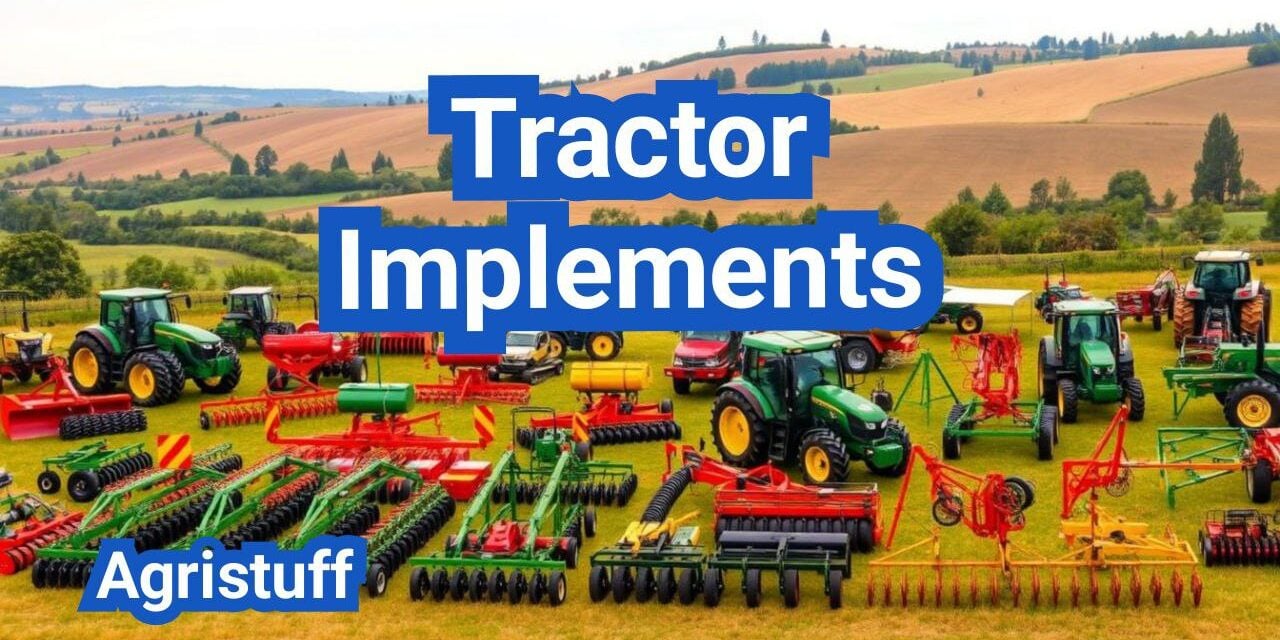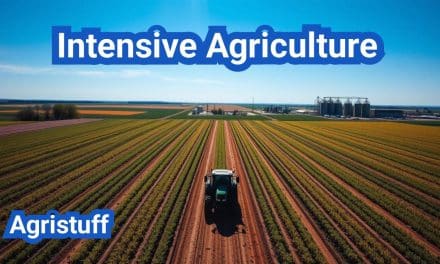Modern farming and landscaping have become more efficient with the use of tractor attachments, transforming the way tasks are performed on farms and homesteads.
These agricultural machinery additions enable farmers to accomplish more in less time, reducing labor and increasing productivity.
A variety of tractor implements are available, each designed for specific tasks, making them indispensable for farm operations.
Key Takeaways
- Tractor attachments increase efficiency in farming and landscaping.
- Various tractor implements are available for different tasks.
- Agricultural machinery reduces labor and increases productivity.
- Farm equipment is essential for modern farming operations.
- Tractor tools enhance the versatility of farm tractors.
The Power of Tractor Implements on American Farms
The use of tractor implements in the U.S. has transformed the agricultural landscape, making farming more manageable and less labor-intensive. Tractor implements are essential tools that enhance the capabilities of tractors, allowing farmers to perform a variety of tasks efficiently.
How Implements Transform Your Tractor’s Capabilities
Tractor attachments can significantly expand the functionality of a tractor, turning it into a multi-purpose machine. For instance, with the right implements, a tractor can be used for plowing, planting, and harvesting, among other tasks. This versatility is crucial for farmers who need to maximize their productivity during planting and harvesting seasons.
Key benefits of tractor implements include:
- Increased efficiency in farm operations
- Enhanced versatility of tractors
- Reduced labor costs due to automation
Economic Benefits of Strategic Implement Selection
Selecting the right tractor implements can have substantial economic benefits for farmers. By choosing implements that are tailored to their specific needs, farmers can reduce operational costs and improve their bottom line. For example, using a box blade for grading and leveling can save time and labor, directly impacting the farm’s profitability.
The economic advantages are further amplified when farmers invest in multi-purpose implements that can be used for various tasks, thereby reducing the need for multiple specialized machines.
The Evolution of Farm Equipment in the U.S.
The history of farm equipment in the United States is marked by significant innovations that have transformed agricultural practices. From the introduction of the steel plow to the development of modern tractor attachments, farm equipment has evolved to meet the changing needs of farmers. Today, tractor implements are designed to be more efficient, durable, and environmentally friendly.
The evolution of farm equipment has been driven by technological advancements and the need for increased productivity. As a result, modern farming has become more mechanized, allowing farmers to cultivate larger areas with less manual labor.
Understanding Attachment Systems and Compatibility
Maximizing tractor efficiency requires a deep understanding of attachment systems and their compatibility. The right attachments can significantly enhance your tractor’s capabilities, while incompatible attachments can lead to inefficiencies and potential safety hazards.
Three-Point Hitch Categories Explained
The three-point hitch is a fundamental attachment system for tractors, allowing for the connection of various implements. There are different categories of three-point hitches, primarily categorized into Category 1 and Category 2, based on their size and the tractor’s horsepower.
- Category 1: Suitable for smaller tractors with lower horsepower, typically under 40 HP.
- Category 2: Designed for larger tractors with higher horsepower, generally between 40 to 100 HP.
Understanding these categories is crucial for selecting the right implements and ensuring compatibility with your tractor.
Quick-Hitch Systems for Rapid Implement Changes
Quick-hitch systems have revolutionized the way farmers and landscapers change implements. These systems allow for rapid attachment and detachment, saving time and reducing labor.
- They simplify the process of switching between different tasks.
- They enhance safety by minimizing the need for manual handling of heavy implements.
- They improve overall efficiency by reducing downtime between tasks.
PTO Connections and Power Requirements
The Power Take-Off (PTO) connection is another critical aspect of tractor-implement compatibility. PTO connections transfer power from the tractor to the implement, and their specifications must match to ensure efficient operation.
Key considerations include:
- PTO shaft size and type.
- The implement’s power requirements in terms of horsepower.
- PTO safety features to prevent accidents.
Hydraulic System Compatibility Considerations
Many modern tractors and implements rely on hydraulic systems for operation. Ensuring that the tractor’s hydraulic system is compatible with the implement’s requirements is vital.
This includes considering:
- The hydraulic flow rate and pressure requirements of the implement.
- The type of hydraulic connections used (e.g., quick couplers).
- The capacity of the tractor’s hydraulic system to support the implement’s needs.
By understanding and addressing these compatibility considerations, users can optimize their tractor’s performance, enhance safety, and improve overall productivity.
Essential Ground Engagement Implements
For farmers and landscapers, the right ground engagement implements can significantly enhance productivity. Ground engagement implements are designed to interact with the soil or ground surface, performing tasks such as grading, leveling, and debris removal.
Box Blades for Grading and Leveling
A box blade for tractor is a versatile implement used for grading and leveling surfaces. It typically consists of a heavy-duty frame with a box-like structure containing blades and scarifiers. Box blades are ideal for tasks such as gravel driveway grading with a tractor, as they can evenly distribute material and remove excess.
Landscape Rakes for Debris Removal
Landscape rakes for tractors are designed to remove debris, level soil, and prepare seedbeds. These rakes feature a series of tines that can be adjusted to different depths, allowing for effective debris removal without damaging the underlying soil.
Rear Blades for Snow Removal and Grading
A rear blade for tractor is a valuable implement for snow removal and grading tasks. It is typically mounted at the rear of the tractor and can be used to push snow or grading material. Rear blades are particularly useful for maintaining driveways and pathways during winter months.
By utilizing these essential ground engagement implements, farmers and landscapers can efficiently manage their tasks, from maintaining gravel driveways to removing debris and snow.
Soil Preparation and Cultivation Implements
Tractor implements play a pivotal role in soil preparation and cultivation, enhancing productivity and efficiency on farms and gardens. These essential tools help in preparing the soil for planting, controlling weeds, and improving soil aeration.
Rotary Tillers for Garden Bed Preparation
Rotary tillers are a crucial implement for breaking up compacted soil and preparing garden beds for planting. A rotary tiller for tractor attachment is particularly effective for larger areas, allowing for deep tilling with minimal effort. By loosening the soil, rotary tillers facilitate root growth and improve soil structure.
The versatility of rotary tillers makes them suitable for various tasks, from creating seedbeds to mixing in compost and fertilizers. When selecting a rotary tiller, consider the size of your tractor and the specific needs of your soil.
Disc Harrows for Field Preparation
Disc harrows are another vital implement for soil preparation, particularly for larger fields. A disc harrow for tractor is designed to cut through soil, break up clods, and prepare the ground for seeding. Disc harrows are effective in managing crop residues and improving soil tilth.
The use of disc harrows can significantly reduce soil compaction and improve drainage. They are also instrumental in controlling weeds by cutting them up and burying them under the soil.
Cultivators for Weed Control and Soil Aeration
Cultivators are indispensable for weed control and soil aeration. A cultivator for tractor attachment is used to loosen the soil around plants, removing weeds and improving air circulation. This not only reduces competition for water and nutrients but also promotes healthy plant growth.
Cultivators come in various types, including row crop cultivators and chisel cultivators, each designed for specific tasks. The choice of cultivator depends on the type of crop, soil condition, and the stage of plant growth.
By incorporating these soil preparation and cultivation implements into your farming or gardening practice, you can significantly enhance the productivity and health of your soil. Whether you’re preparing garden beds with a rotary tiller or managing large fields with a disc harrow, the right tractor implement can make a substantial difference.
Mowing and Cutting Implements

Maintaining large areas of land requires the right equipment, and mowing and cutting implements are essential for the job. Whether you’re managing a farm, a ranch, or a large estate, having the appropriate tools can significantly reduce the time and labor involved in keeping your property well-maintained.
Rotary Cutters for Brush and Rough Areas
Rotary cutters are designed for heavy-duty applications, capable of handling thick brush and rough terrain that regular mowers can’t tackle. They’re ideal for maintaining large areas that are prone to overgrowth, such as fields, pastures, and roadside areas.
Key Features: Heavy-duty construction, ability to cut through thick vegetation, and compatibility with tractors.
Finish Mowers for Manicured Lawns
Finish mowers, on the other hand, are perfect for maintaining manicured lawns and smaller areas where a neat finish is desired. They are designed to provide a clean cut and are often used for lawn maintenance in residential and commercial properties.
Benefits: They offer a precise cut, are generally lighter and easier to maneuver than rotary cutters, and can be used on smaller tractors.
Flail Mowers for Versatile Cutting Applications
Flail mowers are versatile implements that can be used for a variety of tasks, from maintaining grasslands to cutting through small brush. They are known for their ability to leave a mulched finish, which can help in reducing weed growth and maintaining soil health.
- Can be used on various terrain types
- Leaves a mulched finish
- Reduces the need for additional mulching
When choosing between a rotary cutter and a finish mower, consider the terrain and the type of vegetation you’re dealing with. For heavy-duty applications and rough areas, a rotary cutter is likely the better choice. For more manicured areas or smaller properties, a finish mower might be more appropriate.
Digging and Excavation Implements
Digging and excavation are fundamental tasks in both agricultural and construction settings. Implements designed for these tasks are crucial for efficiency and productivity. “The right equipment can make all the difference in the success of a project,” as noted by farming experts.
Post Hole Diggers for Fence Installation
Post hole diggers are a prime example of digging implements. They are used for creating holes for fence posts, signposts, and other structures. A 3-point hitch post hole digger is particularly versatile, attaching easily to tractors. This attachment system allows for efficient digging without the need for additional equipment.
Backhoes for Trenching and Excavation
Backhoes are another critical implement for more extensive digging tasks, such as trenching for water or electrical lines. They offer the capability for both digging and loading material, making them highly versatile on construction sites and farms.
Subsoilers for Breaking Hardpan
Subsoilers are used to break up compacted soil layers, known as hardpan, without inverting the soil. This process improves soil aeration, water infiltration, and root growth. Subsoilers are essential for maintaining soil health and improving crop yields.
By incorporating these digging and excavation implements into their toolkit, farmers and construction workers can significantly enhance their operational efficiency and productivity.
Material Handling Tractor Implements

Material handling is a critical task on farms and in construction, made easier with the right tractor implements. These implements are designed to simplify the process of lifting, moving, and handling various materials, thereby enhancing productivity and reducing labor.
Front-End Loaders for Lifting and Moving
Front-end loaders are among the most versatile tractor implements for material handling. They are used for lifting and moving heavy loads such as soil, sand, and debris. Equipped with a large bucket, front-end loaders can scoop up materials and transport them to different locations. This implement is particularly useful in construction sites and farms where heavy materials need to be relocated frequently.
Pallet Forks for Moving Palletized Loads
Pallet forks are another essential implement for material handling, especially for moving palletized loads. They are designed to lift and transport pallets of goods, making them ideal for farms and warehouses. Pallet forks can be attached to the front of a tractor, allowing for easy maneuverability and precise control over the load.
Grapple Attachments for Brush and Debris Handling
Grapple attachments are used for handling brush, debris, and other irregular materials. These attachments can be fitted to front-end loaders, enhancing their capability to grasp and lift bulky or heavy objects. Grapple attachments are particularly useful in landscaping and forestry applications where clearing brush and debris is a common task.
In conclusion, material handling tractor implements such as front-end loaders, pallet forks, and grapple attachments are indispensable for various industries. They not only improve efficiency but also reduce the manual labor involved in material handling tasks.
Planting and Seeding Implements

The art of planting and seeding has evolved significantly with the introduction of advanced tractor implements designed to enhance efficiency and productivity. These implements are crucial for ensuring that crops are planted and seeded correctly, which is fundamental to achieving a successful harvest.
Broadcast Spreaders for Seed and Fertilizer
Broadcast spreaders are versatile implements used for distributing seeds, fertilizers, and other granular materials across fields. Proper broadcast spreader settings are essential to ensure even distribution and minimize waste. Adjusting the spreader according to the material being distributed is crucial for achieving uniform coverage.
When using broadcast spreaders, it’s also important to consider the type of material being spread. For instance, seeds and fertilizers have different flow characteristics, which may require adjustments to the spreader’s settings.
No-Till Drills for Conservation Farming
No-till drills are designed for conservation farming practices, allowing farmers to plant seeds directly into untilled soil. This method reduces soil erosion and preserves moisture. No-till drill calibration is critical to ensure accurate seed placement and spacing, directly impacting crop yields.
Calibration involves adjusting the drill to accommodate different seed types and sizes, as well as adjusting the depth and spacing of seed placement. Proper calibration ensures that seeds are planted under optimal conditions for germination and growth.
Planters for Row Crops
Planters for tractors are specialized implements designed for planting row crops with precision. Modern planters are equipped with advanced technology, such as GPS guidance, to ensure accurate seed placement and spacing. This precision planting helps in optimizing crop yields and reducing seed waste.
When selecting a planter, farmers should consider factors such as row spacing, seed type, and the tractor’s horsepower to ensure compatibility and optimal performance.
Hay and Forage Implements for Livestock Operations

The success of livestock farming operations often hinges on the quality of hay and forage management. Efficient hay production and handling are crucial for maintaining the health and productivity of livestock. To achieve this, farmers rely on specialized implements designed for hay and forage management.
Hay Tedders for Drying Cut Hay
Hay tedders are essential for accelerating the drying process of cut hay. By spreading and aerating the hay, tedders help to reduce moisture content evenly, preventing mold and spoilage. This implement is particularly valuable in regions with high rainfall or during wet harvest seasons.
Efficient hay drying not only improves the quality of the hay but also reduces storage losses. “Proper tedding can make a significant difference in the overall quality of the hay,” notes an agricultural expert. “It’s a simple yet effective way to ensure that your hay is dry enough for storage.”
Hay Rakes for Windrow Formation
Hay rakes are used to gather cut hay into windrows, making it easier to collect and bale. There are various types of hay rakes, including wheel rakes and bar rakes, each designed for different haying conditions and farm sizes. The choice of rake depends on factors like hay type, field conditions, and the desired level of mechanization.
- Wheel rakes are versatile and work well in a variety of conditions.
- Bar rakes are more aggressive and suitable for heavier hay crops.
Balers for Hay Packaging
Balers are critical for packaging hay into manageable bales that can be easily stored and transported. There are different types of balers, including round balers and square balers, each producing bales of varying sizes and shapes. The choice of baler depends on the farm’s specific needs, including the size of the operation and the type of livestock being fed.
Round balers are popular for their efficiency and ability to produce large, durable bales. “Round balers have revolutionized hay making by reducing labor and increasing efficiency,” according to industry reports.
A baler for tractor is a significant investment for any livestock operation. When selecting a baler, it’s essential to consider compatibility with your tractor, as well as the specific requirements of your haying operation.
Spraying and Fertilizing Implements

Spraying and fertilizing implements are essential for maintaining crop health and maximizing yields. These tractor attachments are designed to efficiently apply fertilizers, pesticides, and other treatments across fields, ensuring uniform coverage and reducing waste.
Boom Sprayers for Field Applications
Boom sprayers are a crucial implement for large-scale farming operations, allowing for the precise application of chemicals and fertilizers over vast areas. When selecting a boom sprayer for tractor, consider the boom width, spray nozzle quality, and compatibility with your tractor’s hydraulic system.
Modern boom sprayers often feature advanced technologies such as GPS guidance and rate control, enabling farmers to optimize their application rates and reduce overlap.
Manure Spreaders for Organic Fertilization
Manure spreaders play a vital role in organic farming by distributing nutrient-rich manure across fields. Proper manure spreader calibration is essential to ensure even distribution and prevent over-application, which can harm crops and the environment.
- Check the spreader’s apron chain and beaters for wear and tear.
- Adjust the spreader’s gate opening to control the application rate.
- Calibrate the spreader on a level surface before field application.
Fertilizer Spreaders for Precision Application
Fertilizer spreaders for tractor are designed for accurate and efficient application of granular fertilizers. These implements come in various types, including broadcast spreaders and spinner spreaders, each suited to different farming needs.
When choosing a fertilizer spreader, consider factors such as hopper capacity, spread width, and the ability to adjust application rates. Some models offer advanced features like spinner disk adjustment and rate control systems for enhanced precision.
By investing in the right spraying implements, farmers can improve crop yields, reduce input costs, and promote sustainable agricultural practices.
Best Tractor Implements for Small Farms

For small-scale farming operations, selecting the right tractor implements is crucial for optimizing labor and resources. The versatility and efficiency of these implements can significantly impact the overall productivity of the farm.
Compact Tractor Attachments for Limited Acreage
Compact tractor attachments are designed for small farms with limited acreage. These attachments are typically lightweight and versatile, making them ideal for tasks such as mowing, tilling, and hauling. Front-end loaders are particularly useful for loading and unloading heavy materials, while rotary cutters are effective for managing brush and small trees.
Other valuable compact attachments include box blades for grading and leveling, and landscape rakes for debris removal and soil preparation. These implements are essential for maintaining a well-manicured farmstead and preparing soil for planting.
Multi-Purpose Implements for Versatility
Multi-purpose tractor implements offer the flexibility to perform a variety of tasks, making them invaluable for small farms where space and budget are limited. Tractor-mounted mowers can be used for mowing large areas, while rotary tillers can till the soil to prepare it for planting.
Implementing a three-point hitch system can greatly enhance the versatility of tractor implements, allowing for easy switching between different attachments. This system is particularly beneficial for small farms, as it reduces the need for multiple specialized tractors.
Budget-Friendly Options for New Farmers
For new farmers or those on a tight budget, there are several budget-friendly tractor implement options available. Used or refurbished implements can offer significant savings while still providing the necessary functionality.
Additionally, multi-functional implements that can perform several tasks can be more cost-effective than purchasing separate specialized implements. New farmers should also consider the long-term durability and maintenance costs of implements when making their selection.
Matching Implements to Your Tractor’s Capabilities

Understanding how to pair your tractor with the right implements can significantly enhance your farming productivity. To achieve optimal performance, it’s crucial to consider several factors that ensure compatibility and efficiency.
Understanding Implement Horsepower Requirements
One of the critical factors in matching implements to your tractor is understanding the horsepower requirements of the implement. The horsepower needed can vary significantly depending on the type of implement, its size, and the task at hand.
For instance, a rotary tiller requires more horsepower than a landscape rake. It’s essential to consult the implement’s manual or manufacturer’s specifications to determine the required horsepower.
“The implement’s horsepower requirement is a critical factor in determining the overall performance and efficiency of your tractor.”
| Implement Type | Typical Horsepower Requirement |
|---|---|
| Rotary Tiller | 20-50 HP |
| Landscape Rake | 10-30 HP |
| Post Hole Digger | 15-40 HP |
Weight and Balance Considerations
Apart from horsepower, the weight and balance of the implement are also crucial. An implement that is too heavy can affect the tractor’s stability, potentially leading to safety issues.
It’s vital to ensure that the tractor’s front axle is not overly stressed by the weight of the implement. Some tractors come equipped with front weights to counterbalance the weight of rear-mounted implements.
Category 1 vs. Category 2 Implement Selection
Tractor implements are categorized based on their hitch type, with Category 1 and Category 2 being the most common for smaller to medium-sized tractors.
- Category 1 implements are designed for tractors with lower horsepower ratings and are typically used on smaller farms or for lighter tasks.
- Category 2 implements are suited for tractors with higher horsepower and are used for more demanding tasks or larger areas.
Selecting the correct category of implement for your tractor is essential for safe and efficient operation.
Implement Maintenance and Storage Best Practices

Effective implement maintenance and storage practices are vital for maximizing the return on your investment in tractor equipment. Regular upkeep not only extends the lifespan of your implements but also ensures they operate at peak performance when needed.
Seasonal Maintenance Schedules
Creating and adhering to a seasonal maintenance schedule is crucial for the longevity of your tractor implements. Before the start of each season, inspect your equipment for any damage or wear. Check for lubrication needs, hydraulic fluid levels, and tire pressure. Addressing these needs before heavy use can prevent breakdowns during critical periods.
For implements with moving parts, such as rotary cutters and disc harrows, ensure that all bearings are properly lubricated. Inspect belts and chains for wear, and replace them if necessary. It’s also essential to check the cutting edges of your implements, like plows and cultivators, and replace them when they become worn.
Proper Storage to Extend Implement Life
Proper storage is a critical aspect of implement maintenance. When storing your tractor implements, choose a location that is dry and protected from the elements. Exposure to rain, snow, and sunlight can cause rust and deterioration of both metal and rubber components.
Before storing, clean your implements thoroughly to remove dirt, debris, and any corrosive materials like manure or salt. Apply a rust inhibitor to metal parts to prevent corrosion. For implements with hydraulic components, retract hydraulic cylinders to prevent rust from forming inside the cylinders.
Common Wear Points and Replacement Parts
Understanding the common wear points on your tractor implements can help you maintain them more effectively. For many implements, cutting edges, bearings, and seals are areas that frequently require attention. Keeping a stock of common replacement parts can minimize downtime when repairs are needed.
Regularly inspect your implements for signs of wear and address issues promptly. For example, worn tines on a hay rake can reduce its effectiveness, while worn blades on a rotary cutter can lead to poor cutting performance and increased strain on the tractor.
PTO Safety and Implement Operation Guidelines
The safe operation of tractor implements is essential for preventing accidents and ensuring a secure working environment on farms and agricultural settings. Tractor implements, while highly beneficial for various tasks, can pose significant risks if not handled properly.
PTO Safety Protocols for Implements
Power Take-Off (PTO) safety is critical when operating tractor implements. PTO shafts can cause severe injuries if not properly guarded or if clothing gets entangled. To mitigate these risks, it’s essential to follow specific safety protocols.
- Always ensure PTO shafts are properly guarded.
- Keep loose clothing tied back and avoid wearing jewelry that could get caught.
- Never approach a PTO shaft while the tractor is in operation.
Safe Hitching and Transport Procedures
Safe hitching and transport procedures are vital for preventing accidents during the movement of tractor implements. Improper hitching can lead to implement detachment, causing accidents or damage.
| Procedure | Description |
|---|---|
| Proper Hitching | Ensure the implement is correctly attached to the tractor’s three-point hitch or drawbar. |
| Secure Transport | Use safety chains or locks to secure the implement during transport. |
| Visibility | Ensure the implement does not obstruct the tractor’s lights or the operator’s view. |
Training Requirements for Implement Operation
Proper training is crucial for the safe operation of tractor implements. Operators should be trained on the specific implements they will be using, including their functions, safety features, and potential hazards.
Key training areas include:
- Understanding implement controls and functions.
- Recognizing potential hazards and taking preventive measures.
- Practicing safe operating procedures under supervision.
By emphasizing PTO safety, safe hitching and transport procedures, and comprehensive training, farmers and agricultural workers can significantly reduce the risks associated with tractor implement operation.
Building Your Tractor Implement Collection Strategically
Building a tractor implement collection is a significant investment for any farming or landscaping operation. By understanding the various types of implements available and their applications, you can make informed decisions to enhance your productivity and efficiency.
Strategic implement selection is crucial to maximizing your tractor’s capabilities. From ground engagement and soil preparation to mowing and material handling, the right implements can save time and labor, ultimately contributing to a more successful operation.
When making a tractor implement investment, consider your specific needs, the compatibility of implements with your tractor, and the potential return on investment. By doing so, you can create a versatile and effective implement collection that supports your long-term goals.
Ultimately, a well-planned implement collection is key to optimizing your farming or landscaping operation, allowing you to tackle a variety of tasks with precision and efficiency.
FAQ
What are the most common tractor implements used in farming and landscaping?
The most common tractor implements include rotary tillers, box blades, landscape rakes, finish mowers, and front-end loaders, which are used for tasks such as soil preparation, grading, debris removal, and material handling.
How do I choose the right tractor implement for my needs?
To choose the right tractor implement, consider the specific tasks you need to perform, the size and type of your tractor, and the implement’s compatibility with your tractor’s attachment system, such as three-point hitch category and PTO connections.
What is the difference between a rotary cutter and a finish mower?
A rotary cutter is designed for cutting thick brush and rough vegetation, while a finish mower is used for maintaining manicured lawns and cutting grass at a precise height.
How do I maintain my tractor implements?
Regular maintenance includes inspecting and replacing worn parts, lubricating moving components, and storing implements properly to protect them from the elements and extend their lifespan.
What safety precautions should I take when operating tractor implements?
Safety precautions include following PTO safety protocols, using safe hitching and transport procedures, and ensuring that operators are properly trained on implement operation and tractor handling.
Can I use a compact tractor for heavy-duty tasks?
While compact tractors are versatile, their capability for heavy-duty tasks depends on their horsepower, attachment system, and the specific implement being used. It’s essential to match the implement to the tractor’s capabilities.
What are the benefits of using a quick-hitch system for tractor implements?
A quick-hitch system allows for rapid implement changes, increasing efficiency and reducing downtime, making it easier to switch between tasks such as mowing, tilling, and loading.
How do I determine the correct implement horsepower requirements?
Implement horsepower requirements are typically specified by the manufacturer and depend on the type and size of the implement, as well as the task it is designed to perform.
What are the advantages of using a three-point hitch system?
A three-point hitch system provides a stable and secure connection between the tractor and implement, allowing for more precise control and easier implement handling.
Can I use tractor implements for snow removal?
Yes, certain tractor implements like rear blades and front-end loaders can be used for snow removal, providing an efficient way to clear driveways, parking lots, and other areas.
How do I calibrate a broadcast spreader for seeding or fertilizing?
Calibration involves setting the spreader according to the manufacturer’s instructions, taking into account factors like spreader type, material being spread, and desired application rate, to ensure accurate and uniform distribution.
What are the benefits of using a no-till drill for planting?
No-till drills allow for planting without disturbing the soil, reducing erosion, preserving soil moisture, and promoting healthier soil conditions, which can lead to improved crop yields and reduced environmental impact.
Conclusion of: The 20 Tractor Implements
On U.S. farms and acreages, tractor implements are the difference between weekend chores and true productivity. The right attachment lets a 25–100+ HP tractor mow, grade, dig, seed, haul, and spray with far less effort; below you’ll find a practical buyer’s guide to tractor implements followed by the 20 time-saving attachments most operators rely on—plus safety, sizing, and setup notes to keep you efficient and compliant. Penn State Extension: Managing Machinery & Equipment
How to choose tractor implements that actually fit your jobs
Start with your top three tasks (mow/brush, grade/maintain lanes, dig/post/plant), then match tractor implements to tractor power, weight, and hydraulic flow; for drawbar and PTO work, horsepower needs depend on implement width, draft, speed, and soil, so use extension calculators to estimate PTO HP before you buy—and avoid oversizing that wastes fuel when selecting tractor implements. Iowa State Ag Decision Maker: Match Tractor Power & Implement Size
Hitch categories, PTO types, and quick-attach basics
Most compact and utility tractors use Category 1 or 2 three-point hitches, so pins and spacing must match your tractor implements; quick-hitch adapters speed hookups but verify compatibility, and know your PTO (transmission-driven vs. live/independent) because control at turns and stops changes the way tractor implements behave. Ohio State CFAES: Safe Implement Hitching (PDF)
Safety first: PTO, loader, bystander, and road risks
Even simple tractor implements are hazardous without guards, shields, and procedures; keep PTO shields in place, disengage before leaving the seat, secure loads, and train family and hired help on hazard zones and thrown-object risks whenever running tractor implements. NIOSH: PTO Safety Alert
20 tractor implements that save serious time and labor
1) Front-End Loader (FEL)
A loader turns your machine into a daily hauler—gravel, mulch, manure, snow—and among all tractor implements, FELs deliver the biggest year-round productivity boost; keep the bucket low in transport, ballast properly, and for bales consider spears or grapples for safe handling, which makes this one of the first tractor implements to buy. UMaine Extension: Front-End Loader Safety
2) Pallet Forks
For moving totes, seed pallets, posts, and lumber, pallet forks are essential tractor implements; watch center of gravity, visibility, and capacity because heavy or high loads raise tip-over risk, and operate slowly on uneven ground so these tractor implements stay stable. Purdue ASEC: Forks & Materials-Handling Hazards (PDF)
3) Box Blade (3-pt)
For driveway maintenance, cut-and-fill, and spreading gravel, a box blade is one of the most cost-effective tractor implements because it pulls material forward and levels; use scarifiers to loosen potholes and washboards before grading with these tractor implements. Clemson Extension: Implements—Part 1
4) Rear/Grader Blade
Rear blades windrow snow, crown lanes, pull ditches, and clean up after storms—making them versatile tractor implements for four seasons; angle and tilt settings are key to shaping water runoff when using these tractor implements. Clemson Extension: Implements—Part 1
5) Rotary Cutter (Brush Hog)
When reclaiming pastures, trails, and road edges, a rotary cutter is the tractor implements workhorse; respect thrown-object zones, never mow with bystanders nearby, keep shields intact, and sharpen blades so your tractor implements cut cleanly. Virginia Tech Extension: Rotary Mower Safety
6) Finish/Grooming Mower
Where turf quality matters (lawns, orchards, campuses), a finish mower leaves a clean cut compared with a brush cutter, and as turf-focused tractor implements you should check deck widths, blade count, and follow PPE guidance so your tractor implements deliver a consistent cut. LSU AgCenter: Mower Setup & Equipment
7) Post-Hole Digger/Auger
Fencing and orchard posts go faster with an auger, but this is one of the most injury-prone tractor implements; use guards and a spotter, avoid loose clothing, and call before you dig to locate utilities so these tractor implements stay safe. Ohio State Extension: Posthole Digger Safety
8) Rotary Tiller
For gardens, food plots, and seedbeds, a tiller gives fine tilth; as with all PTO-driven tractor implements, guard the driveline, disengage before clearing jams, and keep bystanders away so these tractor implements don’t become hazards. Ohio State Ag Safety: Landscape Equipment Tailgate Training (PDF)
9) Disc Harrow
Discs chop residue and prep seedbeds faster than a tiller, and sized correctly they’re efficient tractor implements for pasture renovation and food plots; match width to tractor HP and soil draft to avoid lugging when pulling these tractor implements. Oklahoma State Extension: Disk Harrows
10) Field/Row-Crop Cultivator
For mechanical weed control and residue leveling, cultivators remain relevant tractor implements in vegetables and small grains; adjust depth and sweep spacing to crop rows and soil moisture so these tractor implements don’t uproot young plants. UW Extension: Field Cultivator
11) Landscape Rake (York Rake)
Perfect for raking stones, smoothing soil, and light dethatching, these tractor implements shine in lawn establishment and gravel drive refreshes; angle the rake and make overlapping passes to finish consistently with these tractor implements. Penn State Extension: Lawn Establishment
12) Subsoiler/Ripper
When compaction hurts yields, a subsoiler is the tractor implements answer; rip in proper soil moisture to shatter pans without smearing and avoid deep tillage when not justified so these tractor implements pay back. UGA Extension: Deep Tillage/Subsoiling
13) Middle Buster (Potato Plow)
For trenching, furrowing, and lifting root crops, a middle buster is a simple, low-HP tractor implements option that saves hand labor, making these tractor implements favorites for homesteads. University of Hawaiʻi CTAHR: Planting Potatoes (PDF)
14) Bale Spear/Grapple
Moving round bales safely demands purpose-built tractor implements; use bale spears or grapples instead of buckets to reduce rollback and improve control, and stack carefully with these tractor implements to protect operators and bystanders. Penn State Extension: Moving & Storing Large Hay Bales
15) Sprayer (3-pt or Pull-Type)
From herbicides to liquid fertilizers, a calibrated sprayer is one of the most profitable tractor implements; boom height, nozzle type, pressure, and speed determine coverage and drift, so calibrate at least each season when running these tractor implements. Penn State Extension: Calibrating Boom Sprayers
16) Broadcast/Spinner Spreader
Even nutrient distribution requires a properly set spreader—still one of the most overlooked tractor implements; pattern-test and calibrate for product density, vane settings, and swath width to avoid stripes from these tractor implements. NC State Extension: Fertilizer Spreaders & Calibration
17) Grain/Seed Drill (including No-Till)
Nothing beats a correctly calibrated drill for stand uniformity; among tractor implements, drill setup most influences emergence, so verify seed cup settings, meters, and row units against a catch test when operating these tractor implements. University of Minnesota Extension: Calibrate Grain Drills
18) PTO Wood Chipper/Shredder
Clearing fencerows and storm debris is faster with a PTO chipper, but treat it as one of the most hazardous tractor implements: feed from the side, wear PPE, and keep hands and clothing clear of the infeed whenever using these tractor implements. Virginia Tech Extension: Wood Chipper Safety
19) PTO Snow Blower
In snowy regions, a blower is the winter MVP among tractor implements; set skid shoes to protect surfaces, watch discharge direction, and never clear jams with the PTO engaged when operating these tractor implements. UMN Extension: Snow Removal Safety
20) Manure Spreader
Whether solid or semi-solid, calibrated application turns manure into a fertilizer asset, making spreaders indispensable tractor implements; sheet- or bucket-test for rate and pattern each season to keep these tractor implements accurate. Nebraska Extension: Manure Spreader Calibration
Smart setup tips for better results
Right-sizing tractor implements reduces fuel use and wear because only a portion of max PTO HP reaches the drawbar; ballast, tire pressure, and field conditions matter, and matching tractor implements to the tractor keeps ground speed where it should be. Iowa State AgDM: Tractor Power & Implement Size
Hydraulics, loaders, and road travel
Some tractor implements (grapples, hydraulic top-and-tilt, post drivers) need rear remotes or higher flow, and on roads you must obey SMV/lighting rules and secure wide attachments; thoughtful transport and signaling make tractor implements safer around the public. NDSU Extension: Tractor & Road Safety
Hay tools that multiply dry-down and bale quality
Although not every operation needs them, tedders and rakes can speed drying and boost forage quality—valuable tractor implements for hay producers in humid regions—and using these tractor implements judiciously limits leaf shatter in legumes. UW Team Forage: Equipment to Speed Hay Drying
Maintenance: the time saver few notice
Sharpened blades, correct gearbox oil, intact guards, and greased PTO shafts keep tractor implements running and you on schedule; build seasonal checklists and replace missing shields immediately so your tractor implements don’t create downtime. Illinois Extension: Equipment Care & Safety
FAQ: Hitch categories at a glance
Cat 0 fits garden tractors, Cat 1 dominates compact tractors, and Cat 2 and up handle heavier tractor implements; pin diameters and spacing vary, so use the correct bushings or adapters and verify spec tables before purchasing tractor implements. Cornell Small Farms: Three-Point Hitches
Final Thought
Buy the few tractor implements that remove your biggest bottlenecks first (usually loader, cutter/mower, and a grading tool), then add task-specific tools as your acreage and income grow; size to your PTO HP, protect yourself with shields and training, and recalibrate spreaders and sprayers each season because the small setup habits are where tractor implements save the most time and labor. NIOSH: Agriculture Safety & Health
Sources & References
- Penn State Extension: Managing Machinery & Equipment
- Iowa State Ag Decision Maker: Tractor Power & Implement Size
- Ohio State CFAES: Safe Implement Hitching (PDF)
- NIOSH: PTO Safety Alert
- UMaine Extension: Front-End Loader Safety
- Virginia Tech Extension: Rotary Mower Safety
- LSU AgCenter: Mower Setup & Equipment
- Ohio State Extension: Posthole Digger Safety
- Ohio State Ag Safety: Landscape Equipment Tailgate Training (PDF)
- Penn State Extension: Lawn Establishment
- UGA Extension: Deep Tillage/Subsoiling
- Penn State Extension: Moving & Storing Large Hay Bales
- Nebraska Extension: Manure Spreader Calibration
- NDSU Extension: Tractor & Road Safety
- Cornell Small Farms: Three-Point Hitches
- UW Team Forage: Speeding Hay Drying
- NIOSH: Agriculture Safety & Health










